FUEL TANK - FIRE

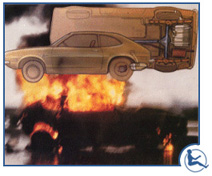 If vehicle occupants survive the trauma of the crash, then they should not burn to death. Recent and current cars, such as the Ford Mustang and Ford Crown Victoria , including the Police Interceptor model, have fuel tanks unsafely located behind the rear axle that get crushed and pierced in rear impacts. This is analogous to the notorious Ford Pinto of the '70's, with its vulnerable fuel tank behind the rear axle. If vehicle occupants survive the trauma of the crash, then they should not burn to death. Recent and current cars, such as the Ford Mustang and Ford Crown Victoria , including the Police Interceptor model, have fuel tanks unsafely located behind the rear axle that get crushed and pierced in rear impacts. This is analogous to the notorious Ford Pinto of the '70's, with its vulnerable fuel tank behind the rear axle.
Police, sheriff, and highway patrol officers from coast-to-coast are needlessly burning to death when their Ford Police Interceptor cars burst into flames in rear-impact collision accidents. These are the successor full-size Fords, along with their Mercury Grand Marquis and Lincoln Town Car siblings, that evolved from the Ford Galaxie 500 and LTD models of the 1965 through 1990's era. They all feature a "deep-well trunk" and "vertical behind-axle" fuel tank that is susceptible to being crushed and punctured in rear-impact crash tests and in fiery accidents on the highway.
The fuel tank system of the recent and current Jeep Liberty sport utility vehicle (and other Jeep models) is unsafe and defectively designed. The fuel tank is located vulnerably behind the rear axle ... placing it within the vehicle's rear "crush zone" (pictured below) where it is certain to become crushed and ruptured in rear-impact collision accidents.
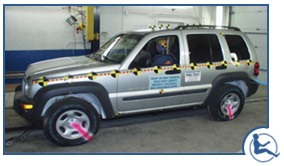 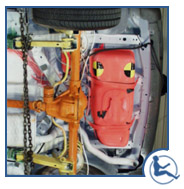
The auto industry has known for decades that the fuel tank for passenger vehicles should not be located behind the rear axle ... as was done in the Ford Pinto and Mustang and Crown Victoria, and many other Ford, GM, Chrysler, and Japanese vehicles up through the mid-1980's and beyond. Instead, the fuel tank should be located in the safety zone forward of the rear axle, where it is protected by distance and structure from collision damage.
Fuel tanks are safer if they are located in a protected zone forward of the rear axle, and also by using anti-puncture shields and internal tough-skin fuel cell bladders, and by eliminating the sharp bolts, brackets, and edges of the "hostile environment" around the fuel tank. Byron Bloch demonstrated the safety merits of the forward-of-axle location in his 1975 Phoenix Crash Test at 63 MPH, with his re-designed fuel tank system embodied in a full-size Ford sedan (as shown below).
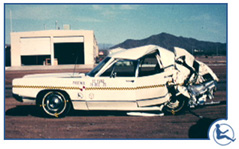 
Filler tubes are often separated from the tank, and need a safety "break-away" feature at the fender, and one-way valves to prevent leakage. One such recent case involved a full-size multi-passenger van with its fuel tank located vulnerably behind the rear axle, with the filler tube inserted through a rubber grommet into a hole located near the bottom of the tank. In the rear-impact collision accident, the filler tube immediately pulled out, and the ensuing fuel-fed fire quickly engulfed the van and its occupants. Mr. Bloch testified as a court-qualified expert in the trial, and the case settled shortly after his testimony began.

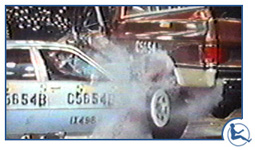 The 1973-through-1987 GM-Chevy C/K pickups have a side-mount fuel tank that is vulnerably located outboard of the main frame rails. After many fiery crashes prompted an investigation, NHTSA determined in 1994 that these 1973-1987 GM-Chevy C/K pickups had a fuel tank safety defect, but before a scheduled public hearing was to take place, the government and GM announced a financial settlement that allowed GM to avoid recalling the trucks and fixing the hazard. So even after hundreds of burn fatalities, these dangerous GM pickup trucks will continue to be involved in fiery crashes. The 1973-through-1987 GM-Chevy C/K pickups have a side-mount fuel tank that is vulnerably located outboard of the main frame rails. After many fiery crashes prompted an investigation, NHTSA determined in 1994 that these 1973-1987 GM-Chevy C/K pickups had a fuel tank safety defect, but before a scheduled public hearing was to take place, the government and GM announced a financial settlement that allowed GM to avoid recalling the trucks and fixing the hazard. So even after hundreds of burn fatalities, these dangerous GM pickup trucks will continue to be involved in fiery crashes.
Many older pre-1973 Ford-GM-Chevy-Dodge pickup trucks had the fuel tank inside the cab right behind the driver, with a protruding filler tube and cap that was easily torn off. This unsafe "in-cab" design was phased out in the mid-1970's.
 The classic Ford Mustang, from the 1965 through 1971 models , had an extremely vulnerable "drop-in" fuel tank... with the top of the fuel tank also serving as the floor of the trunk. And the flimsy filler tube was a perfect target on the rear panel between the tail-lights. Ford's own "Confidential" crash tests showed they knew of the danger, but they never advised the public. The classic Ford Mustang, from the 1965 through 1971 models , had an extremely vulnerable "drop-in" fuel tank... with the top of the fuel tank also serving as the floor of the trunk. And the flimsy filler tube was a perfect target on the rear panel between the tail-lights. Ford's own "Confidential" crash tests showed they knew of the danger, but they never advised the public.
In frontal crashes, high-pressure fuel system components can rupture and tear and separate, spewing out a geyser of gasoline, with an immediate fire in the engine compartment, which spreads to the interior and the passengers. A simple fuel shut-off inertia switch, which automatically stops the electric fuel pump at the start of a crash, has been used in Ford vehicles worldwide for many years, and in many European cars... but there are many vehicles that do not have this safety feature. Automatic fire-extinguishing technology has also been available and practical for many years for usage in motor vehicles, but has been ignored as a "fail-safe" design feature.
|